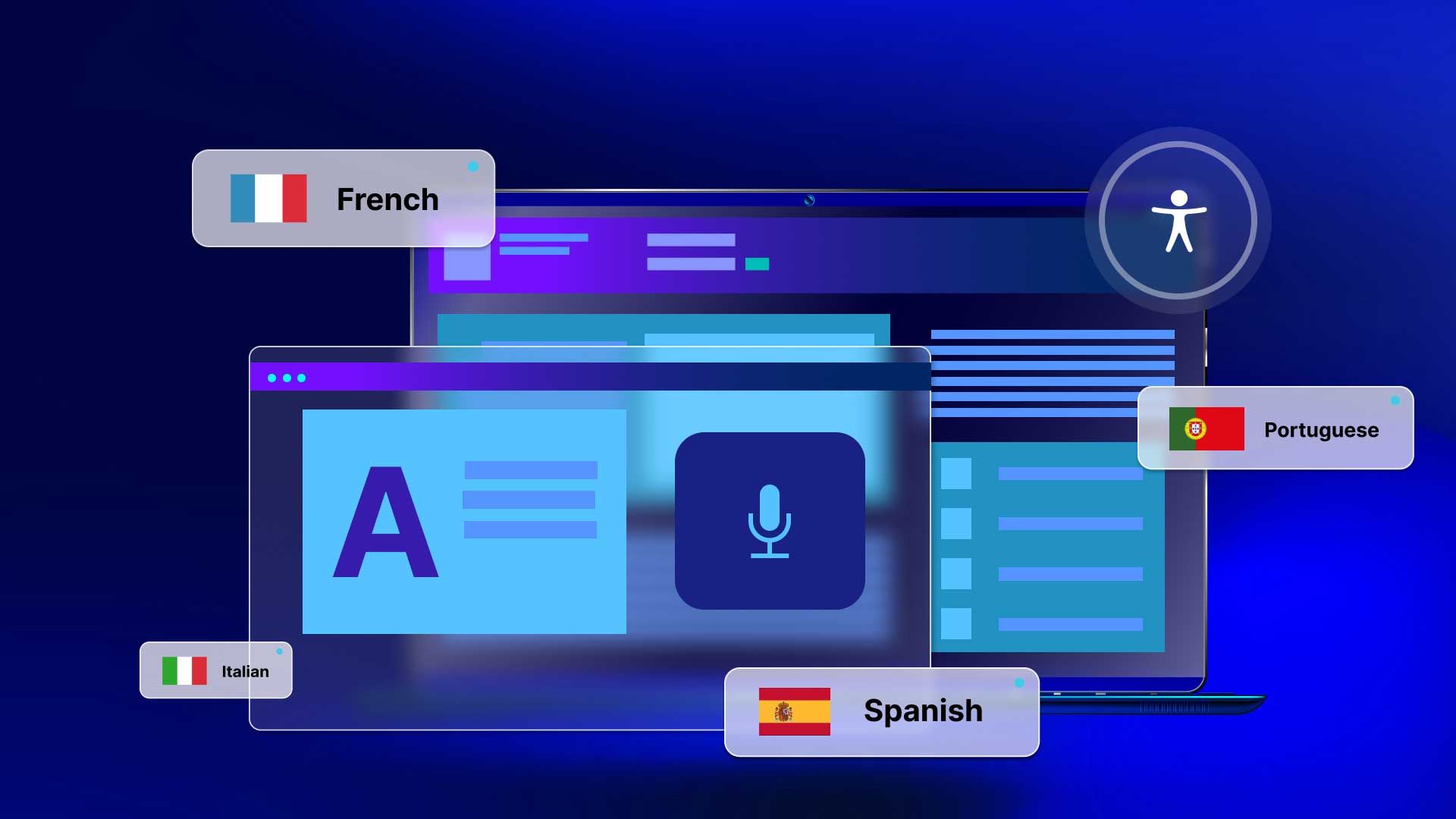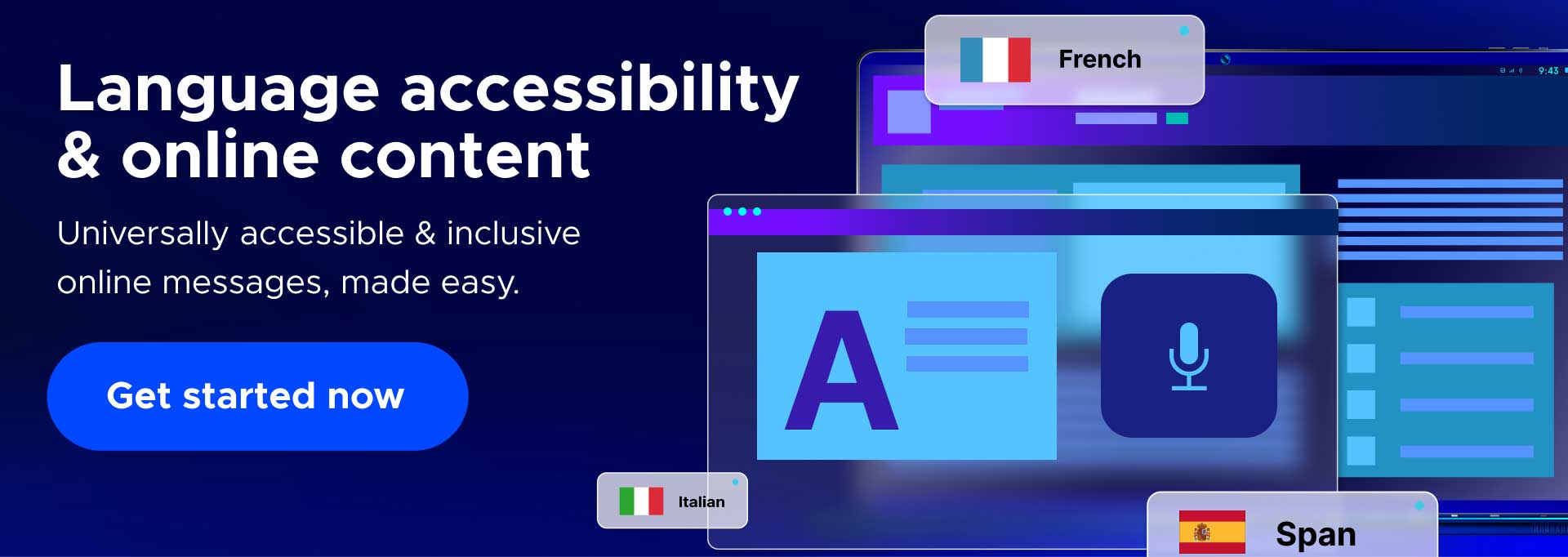Language accessibility: 10 tips for inclusive online content

How can embracing language accessibility transform the way we communicate in our diverse globalized world? In this blog, you’ll learn how language accessibility intersects with digital accessibility and how it all starts with creating online content everyone can understand. This is especially important in an increasingly globalized world, where people of all abilities use digital technology to communicate, transact, and access information.
And, because communication accessibility helps make websites more digitally inclusive, using inclusive language will also help you to conform to The Americans with Disabilities Act (ADA) and the WCAG standards. That way, you can empower everyone to use the web equally and mitigate legal complications for your company.
We start with a basic definition of language accessibility and then move on to tips for achieving it.
What is language accessibility?
Language accessibility broadly encompasses measures that make content accessible to all people. It caters to individuals of diverse ages and abilities, encompassing those with cognitive disabilities, limited literacy, and non-native English speakers. Examples include multilingual website versions, translatable navigation menus, alt text that’s easily readable and understandable, and audio and video content that accommodates end users with limited literacy skills.
Who benefits from accessible language?
1. Non-native speakers: Language accessibility means non-native individuals feel welcomed and are not sidelined due to not being able to understand the language being used. Whether it’s providing translated materials, offering language assistance, or creating multilingual spaces, language accessibility ensures that everyone can participate fully and feel at home in any setting.
2. People with disabilities: Whether it’s people with visual impairments needing screen readers or individuals with auditory impairments needing captions, accessible language empowers everyone to access information, regardless of their abilities.
3. Students: Learning can be challenging enough without language barriers. Making materials accessible means students can focus on understanding the content, rather than struggling with the language.
4. Immigrant communities: Moving to a new country is daunting, and language can be a huge barrier. Accessibility means diverse communities can access vital information about their rights, services, and integration.
5. Businesses: Clear communication is the key to success. Making language accessible ensures companies can reach a wider audience, tap into new markets, and nurture diversity in their workforce.
6. Academia: Education should never have barriers and language should never prevent individuals from accessing their learning. Accessible language means academics can share their findings with the world, advancing knowledge and collaboration.
With much of our lives being conducted online, language accessibility in digital spaces is more important now than ever.
How do translations impact accessible communication?
Translations serve as the ultimate key to unlocking the doors of accessibility. They convert words from one language to another while opening up opportunities, understanding, and connection for people from all walks of life.
Today, websites and apps connect us across continents, making accurate and high-quality translations are more important than ever. They bridge the gap between creators and users, so everyone, regardless of their linguistic background, can fully engage with the content.
Without translations, vital information, services, and cultural treasures would remain locked away, accessible only to those fluent in a particular language. But with translations, the world becomes more inclusive, more vibrant, and more accessible to all. They empower individuals to participate in everyday life and connect with others across linguistic and cultural divides.
This brings us onto the concept of inclusive language which, at its core, is about being mindful of the words we choose and the messages they convey, with the goal of avoiding language that marginalizes or excludes certain groups of people. Let’s unpick exactly what inclusive language looks like.
What are some examples of inclusive language?
Let’s explore some instances where inclusive language plays a vital role in ensuring accessibility and addressing discrimination:
1. Gender-inclusive pronouns: Instead of defaulting to “he” or “she,” use gender-neutral pronouns like “they” or “them” to ensure inclusivity for people of all gender identities.
2. Non-discriminatory job titles: Replace gender-specific job titles like “fireman” or “stewardess” with gender-neutral alternatives such as “firefighter” or “flight attendant” to reflect the diverse workforce.
3. Avoiding gendered language: Instead of using terms like “mankind” or “manpower,” opt for gender-neutral alternatives like “humanity” or “workforce” to acknowledge and include people of all genders.
4. Respectful addressing: Use inclusive language when addressing groups or individuals, such as “everyone” or “folks,” rather than gendered terms like “guys” or “ladies,” to ensure everyone feels included and respected.
5. Person-first language: Put the person before the condition or identity when discussing disabilities or differences, such as saying “person with a disability” instead of “disabled person,” to emphasize the individual’s humanity over their condition.
6. Culturally sensitive terms: Use language that respects and acknowledges cultural diversity, such as referring to Indigenous peoples by their specific tribal names rather than using generic terms like “Native American” or “Indian.”
7. Inclusive imagery: Choose images and illustrations that represent a diverse range of genders, races, ages, abilities, and backgrounds to ensure everyone feels seen and represented.
Language plays a pivotal role in shaping perceptions and attitudes, and within the disability community, the impact of stigma is particularly acute.
In conversations around language accessibility and inclusion, determining the most respectful and empowering language takes center stage. For those striving to be supportive advocates, keeping pace with the evolving preferences of individuals with disabilities is key.
Inclusive language in the disability community
Within the disability community, there’s an ongoing dialogue around the use of inclusive language. The table below highlights some important considerations, offering dos and don’ts to guide inclusive language usage and promote inclusivity within conversations about disabilities.
| Do | Dont’ |
|---|---|
| Use person-first language (e.g., “person with a disability”) | Use derogatory terms or slurs (e.g., “crippled” or “handicapped”) |
| Respect individual preferences for terminology (e.g., “wheelchair user” instead of “confined to a wheelchair”) | Use language that defines individuals solely by their disability (e.g., “disabled person” instead of “person with a disability”) |
| Focus on abilities rather than limitations (e.g., “uses a wheelchair” instead of “wheelchair-bound”) | Assume limitations based on disability (e.g., assuming someone with a mobility impairment cannot participate in certain activities) |
| Emphasize accessibility and accommodation (e.g., “accessible parking” or “accommodations for those with visual impairments”) | Ignore or neglect accessibility needs (e.g., not providing ramps or accessible formats for information) |
| Use language that empowers and includes individuals (e.g., “accessible to all” or “inclusive environment”) | Use language that reinforces stereotypes or pity (e.g., “suffering from” or “victim of”) |
| Use ‘non-disabled person/people’ | Use ‘able-bodied /normal people’ |
If in doubt, (and to prevent unintentional offense), it’s best to respectfully ask how an individual prefers to be referred to regarding their condition, diagnosis, or disability, acknowledging their individuality and creating a space for open communication.
Let’s walk through 10 tips to get you started to improve communication accessibility.
10 tips to build better digital content
1. Use headings for optimal organization
End users, particularly those who rely on screen readers, tend to skim online content. Headings make it easier to do that. It also helps to use consistent formatting for headers so that end users can easily predict and understand your communication hierarchy.
2. Omit the fluff
Avoid using marketing “fluff” or filler words to over-convey your value proposition. End users only want content (product and service info) that matters to them and want it as quickly as possible.
3. Always provide alt text
These image descriptions enable screen readers to convey content out loud or convert it to Braille for people with visual impairments.
4. Make your purpose clear
People typically only read the beginning of content sections, determining whether they want to read more. So start with clearly conveyed messaging that’s engaging and accessible for everyone.
5. Avoid using too many words
Remember, you only have a few seconds to capture and retain end users’ attention. So, carefully edit your web content and remove unnecessary, overused words and phrases like significantly, only, very, and I believe.
6. Spell out the acronyms
Always spell out the first mention of an acronym to ensure easier readability and comprehension.
7. Be consistent
Don’t create confusion by using different words to convey the same idea. For example, if you use doctor instead of medical expert once, use that phrase throughout your online content.
8. Always use the active voice
Use the active voice (The boy chases the cat.) instead of the passive voice (The boy is chasing the cat.) Note that the subject (the boy) performs the action in the active voice, which is more direct and easier to understand.
9. Provide content in bite-sized chunks
Use a maximum of five sentences for each paragraph, and don’t exceed 25 words per sentence.This approach accommodates most end users, who prefer to digest content in small blocks instead of wading through lengthy, tedious prose.
10. Avoid idioms
Avoid phrases unique to a specific region. For instance, “you rock!” may not universally resonate with all people. So, it’s critical to understand your target audience intimately, including those with disabilities and language barriers.
Incorporating accessible language is a significant first step in your digital accessibility journey – see how UserWay can guide you the rest of the way.
UserWay: your all-in-one accessibility solution
Digital accessibility requires implementing accessibility tools, adhering to law and embracing best practices. It also includes the language we use in our digital environments. To achieve an equitable digital space requires a continuous commitment to empathy, respect, and inclusion.
UserWay’s AI-driven accessibility tools are built to promote web inclusivity and language accessibility while helping your company conform to all regulatory standards. Let’s work as a team to make the world more inclusive of everyone.
Start with a friendly consultation, or start your free trial right away.
FAQs
What does the WCAG require for language accessibility?
Go straight to the source, the official WCAG website, for the best answer to this question.
Why does language accessibility matter?
Language should never be an access barrier in the physical world, just as it should never be an obstacle in the digital world. That’s why language accessibility is a practical and ethical imperative for companies of any size and background.
What’s the purpose of a language access plan?
This crucial document outlines how to serve non-English speaking people or those with limited proficiency. Of course, an effective language access plan is customizable for each organization. Nonetheless, some universal components—needs assessment, language services offered, notices, training for staff, and evaluation—are generally accepted best practices for any language access plan.





Share